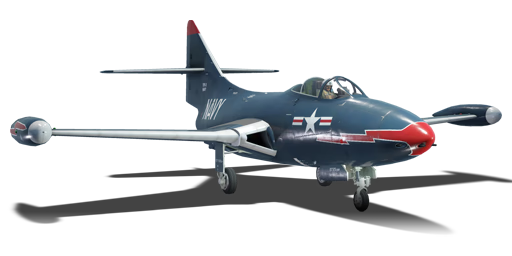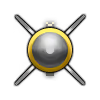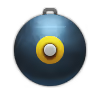



The F9F-5 was a significant improvement over the F9F-4. It had substantial airframe changes over the F9F-4 such as a longer fuselage. More importantly, it had the Pratt & Whitney J48 turbojet which produces over 3,000 kgf. Over 600 F9F-5s were delivered to Naval squadrons and would end up serving in the Korean War. The F9F-5 was also used by the Blue Angels flight team until they were replaced by the F9F-8 Cougar in 1954. In 1962, F9F-5s would end up being redesignated as either target drones or drone directors until their final retirement a few years later.
Introduced in Update 1.33, the F9F-5 is a decent aircraft. Players can use it as a fighter-bomber thanks to its decent flight characteristics and expansive bomb loadouts. It has the standard Panther gun loadout of four chin-mounted 20 mm cannons which are quite deadly with the air target belt. The F9F-5 is commonly outclassed by other fighters so players should not be hyper-aggressive and stick to supporting teammates. In a pinch, the F9F-5 can turn quite well which unfortunately comes at the cost of heavily draining energy. Nonetheless, the F9F-5 is sufficient in its role of fighting enemy aircraft; as well as bombing ground targets like tanks and pillboxes.
flaps
flaps
flaps
brake
| Belt | Belt filling | Armor penetration (mm) at a distance: | |||||
|---|---|---|---|---|---|---|---|
| 10 m | 100 m | 500 m | 1000 m | 1500 m | 2000 m | ||
| HEF-I/AP-T | 36 | 33 | 23 | 15 | 9 | 6 | |
| AP-T/AP-T/HEF-I/HEF-I | 36 | 33 | 23 | 15 | 9 | 6 | |
| HEF-I/HEF-I/HEF-I/AP-T | 36 | 33 | 23 | 15 | 9 | 6 | |
| AP-T/AP-T/AP-T/HEF-I | 36 | 33 | 23 | 15 | 9 | 6 | |
| HEF-I | 5 | 4 | 3 | 3 | 3 | 3 | |
| Name | Weight | Slot | ||||||||
|---|---|---|---|---|---|---|---|---|---|---|
| 62.8 kg |  |  |  |  |  |  | ||||
| 49.9 kg |  |  |  |  |  |  |  |  | ||
| 117.9 kg |  |  |  |  |  |  |  |  | ||
| 242.6 kg |  |  |  |  |  |  | ||||
| 500.8 kg |  |  | ||||||||












Flight performance | |
|---|---|
Survivability |
|---|
Weaponry | |
|---|---|